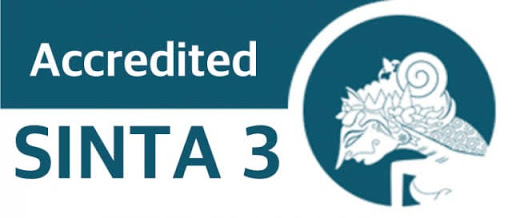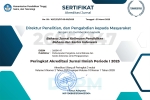Teachers’ Beliefs of Monolingualism in an International School
Abstract
This research explores the beliefs of Indonesian EAL teachers about monolingualism, they saw it as a challenge or a benefit and how they perceived students’ native language conducted in one of the International Schools in Jakarta, Indonesia. The participants of this research were three Indonesian EAL teachers who worked in an International School in Jakarta. This researched employed qualitative research, and semi-structured interviews to collect the data. For data analysis, this researched utilised thematic analysis to analyse and examine the similarity and differences from research participants response. The findings stated that Indonesian EAL teachers recognised monolingualism as a disadvantage. Furthermore, using one language in the classroom, it raised the challenges included students at the beginner level was struggling to communicate and exchange their minds if they did not know how to express themselves in English and the needed to balance content and language for the teachers. Due to these challenges, the strategies in classroom included small groups with mixed abilities of students’ English level and with one country. In addition, Indonesian EAL teachers perceived students' native language as a resource that should be taught at school, and it was helpful in expressing their thoughts and understanding the material.
Abstrak
Penelitian ini mengeksplorasi keyakinan guru EAL Indonesia tentang monolingualisme, bagaimana mereka memandangnya sebagai tantangan atau manfaat, dan bagaimana mereka memandang bahasa ibu siswa yang dilakukan di salah satu Sekolah Internasional di Jakarta, Indonesia. Partisipan penelitian ini adalah tiga guru EAL Indonesia yang bekerja di Sekolah Internasional di Jakarta. Penelitian ini menggunakan penelitian kualitatif dan wawancara semi-terstruktur untuk mengumpulkan data. Untuk analisis data, peneliti menggunakan analisis tematik untuk menganalisis dan memeriksa persamaan dan perbedaan dari tanggapan partisipan penelitian. Temuan penelitian menyatakan bahwa guru EAL Indonesia mengakui monolingualisme sebagai kerugian. Lebih lanjut, penggunaan satu bahasa di kelas menimbulkan tantangan, termasuk siswa tingkat pemula yang kesulitan berkomunikasi dan bertukar pikiran jika mereka tidak tahu cara mengekspresikan diri dalam bahasa Inggris, serta kebutuhan untuk menyeimbangkan konten dan bahasa bagi guru. Karena tantangan ini, strategi di kelas mencakup kelompok-kelompok kecil dengan kemampuan bahasa Inggris siswa yang beragam dan dengan satu negara. Selain itu, guru EAL Indonesia memandang bahasa ibu siswa sebagai sumber daya yang harus diajarkan di sekolah, dan hal itu membantu dalam mengekspresikan pikiran mereka dan memahami materi.
.
Keywords
Full Text:
PDFReferences
Ammar, A., Lightbown, P. M., & Spada, N. (2010). Awareness of L1/L2 Differences: Does it Matter?. Language Awareness, 19(2), 129—146. https://doi.org/10.1080/09658411003746612
Artieda, G. (2017). The Role of L1 Literacy and Reading Habits on The L2 Achievement of Adult Learners of English as a Foreign Language. System, 66, 168—176. http://dx.doi.org/10.1016/j.system.2017.03.020
Ascher, H. R., & Pichery, K. M. (2024). Language Policy in English as a Medium of Instruction Schools: A Multilingual Approach. In Handbook of Research on Critical Issues and Global Trends in International Education (pp. 260—283). IGI Global. https://doi.org/10.4018/978-1-6684-8795-2.ch011
Barcelos, A. M. F. (2003). Teachers' and Students' Beliefs Within a Deweyan framework: Conflict and Influence. In P. Kalaja, & A. M. F. Barcelos (Eds.), Beliefs about SLA: New research approaches (pp. 171—199). Dordrecht: Kluwer Academic Publishers.
Berg, B. L. (2001). Qualitative Research Methods for the Social Science. Allyn & Bacon.
Bruen, J., & Kelly, N. (2014). Using a Shared L1 to Reduce Cognitive Overload and Anxiety Levels in The L2 Classroom. The Language Learning Journal, 45(3), 368–381. https://doi.org/10.1080/09571736.2014.908405
Carder, M. (2014). Tracing The Path of ESL Provision in International Schools Over the Last Four Decades. International Schools Journal, 34(1), 85—96.
Choi, T. H., & Leung, C. (2017). Uses of First and Foreign Languages as Learning Resources in a Foreign Language Classroom. Journal of Asia TEFL, 14(4), 587. http://dx.doi.org/10.18823/asiatefl.2017.14.4.1.587
Constantin-Dureci, G. (2022). Challenging Dominant Language Ideology in the Adult ESL Classroom: A Case Study. Studies in Applied Linguistics & TESOL, 22(1). https://doi.org/10.52214/salt.v22i1.8726
Dobinson, T., & Buchori, S. (2016). Catering for EAL/D Students' Language Needs in Mainstream Classes: Early Childhood Teachers' Perspectives and Practices in One Australian Setting. Australian Journal of Teacher Education (Online), 41(2), 32-52. https://doi. org/10.14221/ajte.2016v41n2.3
Ellis, E. M. (2008). Defining and Investigating Monolingualism. Sociolinguistic Studies. https://www.academia.edu/10752950/Defining_and_investigating_monolingualism
Firman, H. & Tola. (2008). The Future of Schooling in Indonesia. Journal of International Cooperation in Education, 11(1), 71–84. https://cice.hiroshima-u.ac.jp/wp-content/uploads/publications/Journal11-1/11-1-6.pdf
García Jiménez, S. P. (2024). The Use of L1 in a Beginner L2 English Classroom: A Case Study in Mexico. Open Journal for Studies in Linguistics, 7(2). https://doi.org/10.32591/coas.ojsl.0702.02059g
Gundarina, O., & Simpson, J. (2022). A Monolingual Approach in an English Primary School: Practices and Implications. Language and education, 36(6), 523—543. https://doi.org/10.1080/09500782.2021.1945084
Kallon, I. I., & Colvin, C. J. (2022). A Qualitative Exploration of Continuity of TB Care in Clinics After Discharge from Hospitals in Cape Town, South Africa. BMC Health Services Research, 22(1), 1489. https://doi.org/10.1186/s12913-022-08880-9
Khetaguri, T., Zangaladze, M., & Albay, M. (2016). The Benefits of Using L1 in Foreign Language Learning Process. International Journal of Social Sciences & Educational Studies, 2(3), 24—26. https://www.ijsses.tiu.edu.iq/index.php/ijsses/article/view/602
Lim, W. M. (2025). What is Qualitative Research? An Overview and Guidelines. Australasian Marketing Journal, 33(2), 199—229.
https://doi.org/10.1177/14413582241264619
List of every International School in Jakarta.(2024). @IntSchoolsDB. https://www.international-schools-database.com/in/jakarta
Mezmir, E. A. (2020). Qualitative Data Analysis: An Overview of Data Reduction, Data Display, and Interpretation. Research on Humanities and Social Sciences, 10(21), 15—27. https://doi.org/10.7176/RHSS/10-21-02
Miles, M. B., & Huberman, A. M. (1994). Qualitative data analysis: An expanded sourcebook. Sage.
Miller, J., Windle, J. A., & Yazdanpanah, L. K. (2014). Planning Lessons for Refugee-Background Students: Challenges and Strategies. International Journal of Pedagogies & Learning, 9(1), 38—48. https://doi.org/10.1080/18334105.2014.11082018
Phakiti, A. (2014). Experimental Research Methods in Language Learning. Bloomsbury Publishing.
Pinter, A. (2007). Some Benefits of Peer-Peer Interaction: 10-Year-Old Children Practicing with a Communication Task. Language Teaching Research, 11(2), 189—207. https://doi.org/10.1177/1362168807074
Raspel, L. (2019). Teachers’ and Students’ Language Use in Foreign Language Classroom: An Analysis of The Role of L1 in Target Language Learning (Doctoral dissertation, University of Portsmouth).
Reid, K. N. (2015). A Case Study of the Experiences of Small Group Work for Newly Arrived EAL Pupils in a Secondary School: Perceptions of Teachers, Teaching Assistants and Pupils (Doctoral dissertation, University of Warwick).
Rodríguez-Izquierdo, R. M. (2022). Monolingual Ideologies of Andalusian Teachers in the Multilingual Schools’ Context. International Journal of Bilingual Education and Bilingualism, 25(7), 2482–2494. https://doi.org/10.1080/13670050.2021.1918627
Rozi, N. (2023). English Language Teaching in Indonesia: Monolingual and Multilingual Practices. K@ta, 25(00), 88—95. https://doi.org/https://doi.org/10.9744/kata.25.00.88-95
Rutledge, P. B., & Hogg, J. L. C. (2020). In‐Depth Interviews. The international encyclopedia of media psychology, 1—7. https://doi.org/10.1002/9781119011071.iemp0019
Shin, J. Y., Dixon, L. Q., & Choi, Y. (2020). An updated review on use of L1 in foreign language classrooms. Journal of multilingual and multicultural development, 41(5), 406-419. https://doi.org/10.1080/01434632.2019.1684928
Slaughter, Y., & Cross, R. (2021). Challenging The Monolingual Mindset: Understanding Plurilingual Pedagogies in English as an Additional Language (EAL) Classroom. Language Teaching Research, 25(1), 39—60. https://doi.org/10.1177/1362168820938819
Spencer, J. (2021). Understanding EAL: International Secondary School Teachers’ Experiences and Attitudes in Ukraine and Eastern Europe. Journal of Research in International Education, 20(2), 171–186. https://doi.org/10.1177/14752409211033749
Spiro J., & Crisfield E. (2018). Linguistic and Cultural Innovation in Schools: The Languages Challenge. Palgrave Macmillan.
Strobbe, L., Van Der Wildt, A., Van Avermaet, P., Van Gorp, K., Van den Branden, K., & Van Houtte, M. (2017). How School Teams Perceive and Handle Multilingualism: The Impact of a School's Pupil Composition. Teaching and Teacher Education, 64, 93—104. https://doi.org/10.1016/j.tate.2017.01.023
DOI: https://doi.org/10.26499/bahasa.v7i2.1563
Refbacks
- There are currently no refbacks.

This work is licensed under a Creative Commons Attribution-NonCommercial-ShareAlike 4.0 International License.
This work is licensed under a Creative Commons Attribution-ShareAlike 4.0 International License.
Apartemen Suite Metro
Jalan Soekarno Hatta No. 698B, Kelurahan Jatisari - Kecamatan Buahbatu Bandung, Jawa Barat 40286
























